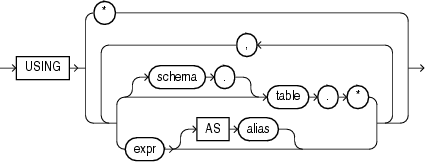42.2 CLUSTER_DISTANCE
Syntax
cluster_distance::=
Analytic Syntax
cluster_distance_analytic::=
mining_attribute_clause::=
mining_analytic_clause::=
See Also:
"Analytic Functions" for information on the syntax, semantics, and restrictions of mining_analytic_clause
Purpose
CLUSTER_DISTANCE returns a cluster distance for each row in the selection. The cluster distance is the distance between the row and the centroid of the highest probability cluster or the specified cluster_id. The distance is returned as BINARY_DOUBLE.
Syntax Choice
CLUSTER_DISTANCE can score the data in one of two ways: It can apply a mining model object to the data, or it can dynamically mine the data by executing an analytic clause that builds and applies one or more transient mining models. Choose Syntax or Analytic Syntax:
-
Syntax — Use the first syntax to score the data with a pre-defined model. Supply the name of a clustering model.
-
Analytic Syntax — Use the analytic syntax to score the data without a pre-defined model. Include
INTOn, wherenis the number of clusters to compute, andmining_analytic_clause, which specifies if the data should be partitioned for multiple model builds. Themining_analytic_clausesupports aquery_partition_clauseand anorder_by_clause. (See "analytic_clause::=".)
The syntax of the CLUSTER_DISTANCE function can use an optional GROUPING hint when scoring a partitioned model. See GROUPING Hint.
mining_attribute_clause
mining_attribute_clause identifies the column attributes to use as predictors for scoring. When the function is invoked with the analytic syntax, this data is also used for building the transient models. The mining_attribute_clause behaves as described for the PREDICTION function. (See "mining_attribute_clause".)
See Also:
-
Oracle Machine Learning for SQL User’s Guide for information about scoring.
-
Oracle Machine Learning for SQL Concepts for information about clustering.
Note:
The following example is excerpted from the Oracle Machine Learning for SQL examples. For more information about the examples, see Appendix A in Oracle Machine Learning for SQL User’s Guide.
Example
This example finds the 10 rows that are most anomalous as measured by their distance from their nearest cluster centroid.
SELECT cust_id
FROM (
SELECT cust_id,
rank() over
(order by CLUSTER_DISTANCE(km_sh_clus_sample USING *) desc) rnk
FROM mining_data_apply_v)
WHERE rnk <= 11
ORDER BY rnk;
CUST_ID
----------
100579
100050
100329
100962
101251
100179
100382
100713
100629
100787
101478


